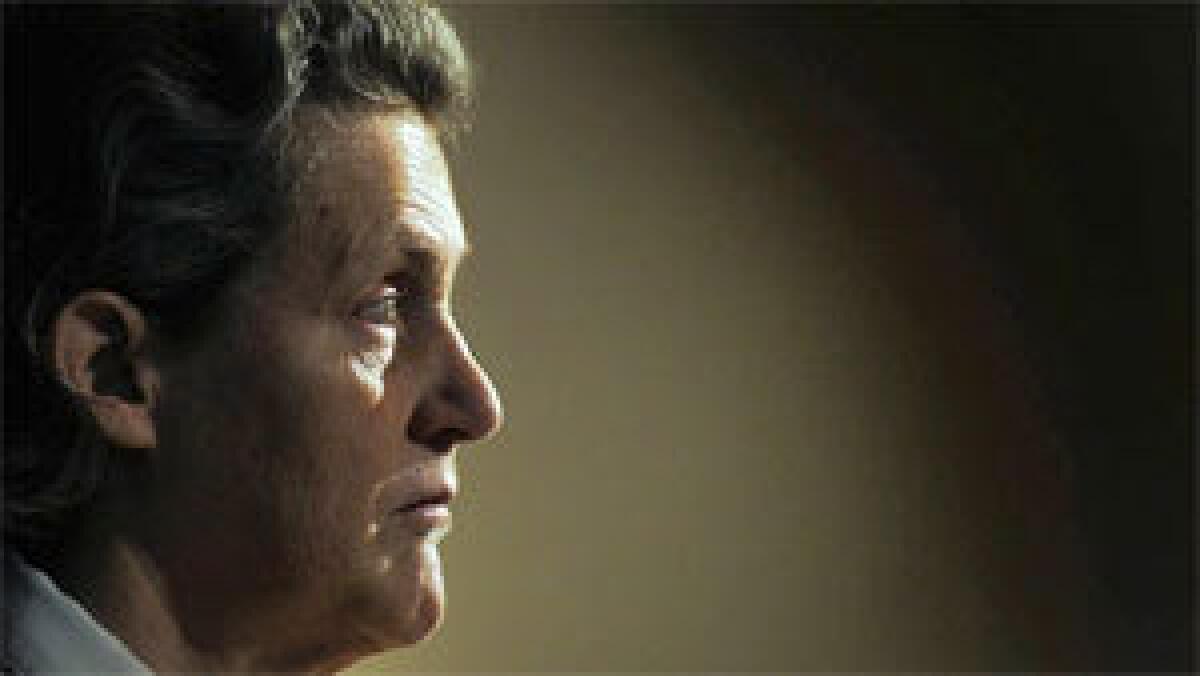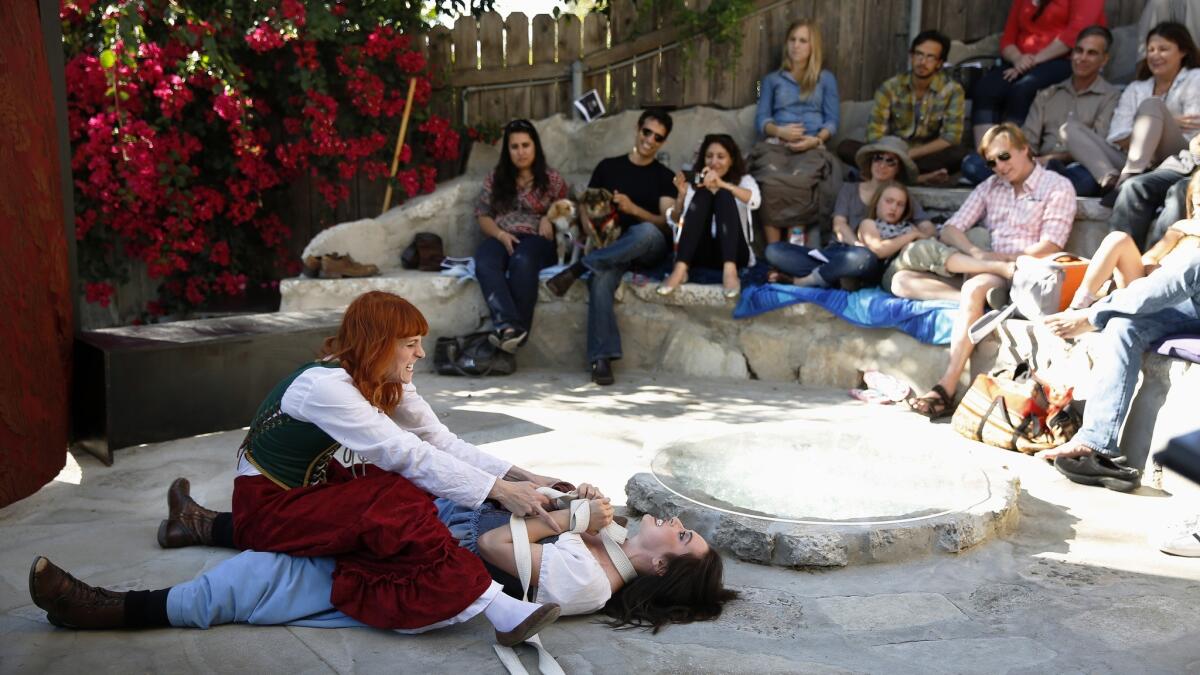At 100 years old, Grand Central still holds secrets
No one knows the New York landmark’s 100-year history like its ‘docent in chief,’ who regales and teases VIP tour groups with hints about its secrets and mysteries.
- Share via
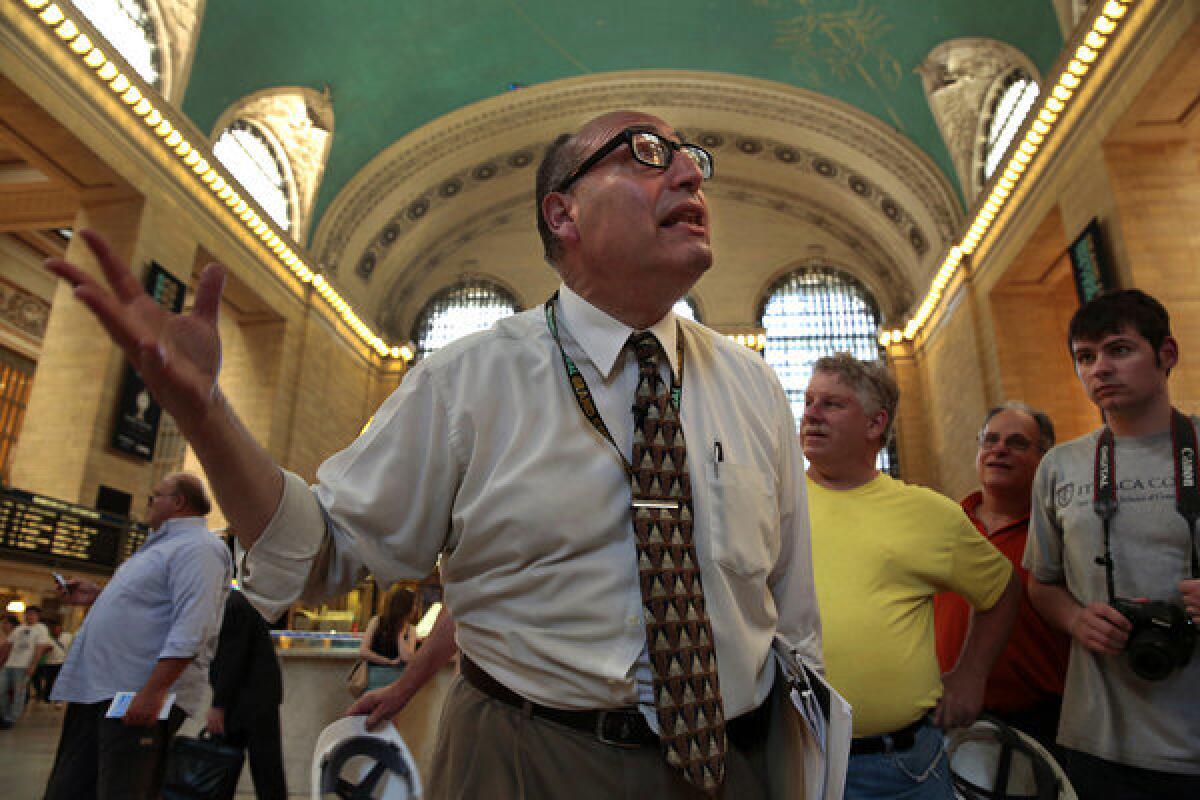
D
anny Brucker, an oval-shaped man wearing black horn-rimmed glasses and a harried look, stared at the students circling him.
"If you thought you were going to get a tour of Grand Central Station, you were WRONG!" he screeched in a voice that carried above the lunch-hour din. "That's because it's a TERMINAL!"
Brucker explained the difference to his perplexed audience: Trains pass through a station, but their journeys end at a terminal.
Grand Central Terminal turned 100 years old this year, and if "Happy Birthday" were sung, the loudest voice would be that of Brucker, unofficially Grand Central's chief historian and officially a spokesman for the Metro-North Railroad, whose trains begin and end their runs here.
Brucker rises at 3:30 a.m. each workday to make the three-hour trek by train from his New Jersey home to the place he calls "the world's largest talent."
"There's just one problem," said Brucker, 60. "The talent doesn't do anything. It just sits there. It looks great, but it doesn't speak."
That's Brucker's job. He joined Metro-North's public relations office 25 years ago and soon found himself researching the terminal's history and architectural oddities in response to questions from historians, documentary filmmakers and journalists.
He was eventually anointed Grand Central's "docent in chief," as his business cards now read. It's a job that, by his estimate, involves leading at least 140 VIP tours each year through the Beaux Arts behemoth in Midtown Manhattan.
At the start of each tour, Brucker stands at the center of the buzzing main concourse and playfully hints at the terminal's secrets and mysteries.
"There's a 35,000-square-foot mistake in here!" he told the 17 students and instructors from the New York School of Interior Design one recent day.
"And I bet you didn't know that there's a jewel hidden in plain sight in here, worth $10 [million] to $20 million," Brucker said. "Or a secret stairway."
He pointed at the huge board with its digital display of train departure times and track numbers. "Every single one of those is wrong!" he said, as the students looked from the dramatically gesticulating Brucker to the black board with its rows of letters and numbers.
After enticing them with these hints, he would say no more.
"Ah! But not till the end of the tour," he said mischievously.
Then they were off. Brucker briskly zigzagged through the crowd, and the tour group strained to keep up.
...we might have some deeply buried secrets, we might be a lot less than perfect — but this terminal is giving us a message about reclamation, about reinvention."— Danny Brucker
"I didn't know they had a Junior's here!" one young woman shrieked as the group veered through Grand Central's dining concourse, past the diner famous for its cheesecake, en route to the "whispering gallery," an alcove whose dome ceiling sends the softest of voices bouncing from one corner to another.
Brucker's tour groups have included ambassadors, politicians, rock stars, movie actors and TV personalities, most of whom he wouldn't have recognized had others not pointed them out. He has no TV or computer at home and avoids the movies. His relatives are all dead, as is his beloved Maine coon cat.
In his spare time, he listens to opera on a turntable that plays his collection of vinyl albums. Brucker sees himself as a human version of Grand Central; they both revel in the past as the world swirls around at breakneck speed.
"The terminal and I have a lot in common," said Brucker, who has become a familiar presence to Grand Central regulars — workers and commuters alike — and a bit of a celebrity himself. A Japanese tourist stopped him one morning waving his camera. He wanted a picture of himself with Brucker, whom he had seen in a documentary about Grand Central.
"I bet you didn't know there's an elevator here," Brucker said as he steered the design school group up a ramp toward a lift that would take them to a floor used only by terminal workers. Unlike the Old World glamour of Grand Central's public face, this floor was a dim industrial-like maze of narrow passages and metal doors, one of which opened to reveal Brucker's reason for bringing visitors here.
"Get your cameras ready!" he said before ushering them onto a glass catwalk about 110 feet above the main concourse. Tiny figures moved about the floor below like bees jostling for space in a hive.
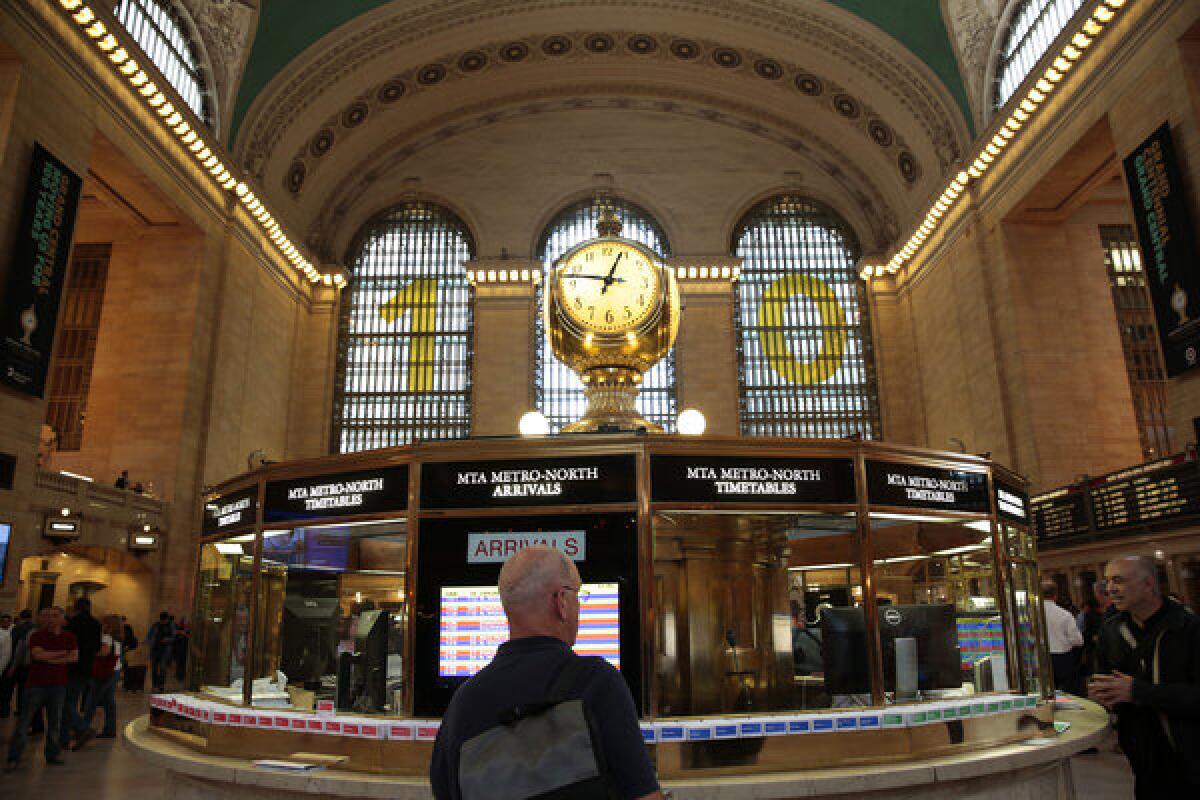
The clock in the middle of Grand Central holds a secret. The little point at the top is a compass that's aligned to true north, so the four sides of the clock line up perfectly with the four compass points of the building. More photos
From there, Brucker guided them to a window facing the outside and ordered them to gaze out and appreciate the view of the Chrysler Building gargoyles glistening in the sun.
The catwalk allows terminal workers to pass quickly from one end of the building to the other. Three stories higher are the workings of the 13-foot-wide Tiffany clock that looms over 42nd Street, its golden glass sun set against a blue background and surrounded by giant white Roman numerals.
Some of Brucker's tours stop in the "situation room," where transit officials huddle to discuss potential emergencies. Visitors can watch the terminal's equivalent of an air traffic control tower, where a computer screen displays lines of red, yellow, green, blue and white that represent different lines on different tracks.
Others head to the public tennis courts on the fourth floor, which for 25 years housed the CBS television studios. Now, for $75 to $225 per hour, depending on the time and day, anyone can swing a racket there.
Each day, about 750,000 commuters, tourists, shoppers and diners enter Grand Central, the world's largest train terminal, with 63 tracks, 45 platforms and an expanse of 49 acres, from 42nd to 97th streets. Metro-North operates about 700 trains daily to and from areas north of New York City.
The main concourse, with its two staircases modeled after those in the Paris Opera, covers 35,000 square feet. Its information booth fields more than 1,000 questions daily. There are 68 shops that line the grand hallways that empty into the concourse. In a far corner of the dining court, the lost-and-found takes in about 2,000 items a month — among them a prosthetic leg, a dog and a set of dentures.
But it is its history that Brucker and the terminal's other aficionados like to emphasize. In the 1960s, as Americans abandoned the rails in favor of cars and planes, the railroad that owned Grand Central proposed building an office tower atop the rundown terminal.
The demolition of another architectural wonder, New York's Pennsylvania Station, galvanized New Yorkers to protect Grand Central. Spurred on by Jacqueline Kennedy Onassis, the city's battle led to a U.S. Supreme Court ruling in 1978 that cemented the terminal's landmark status and set the stage for a 20-year restoration project.
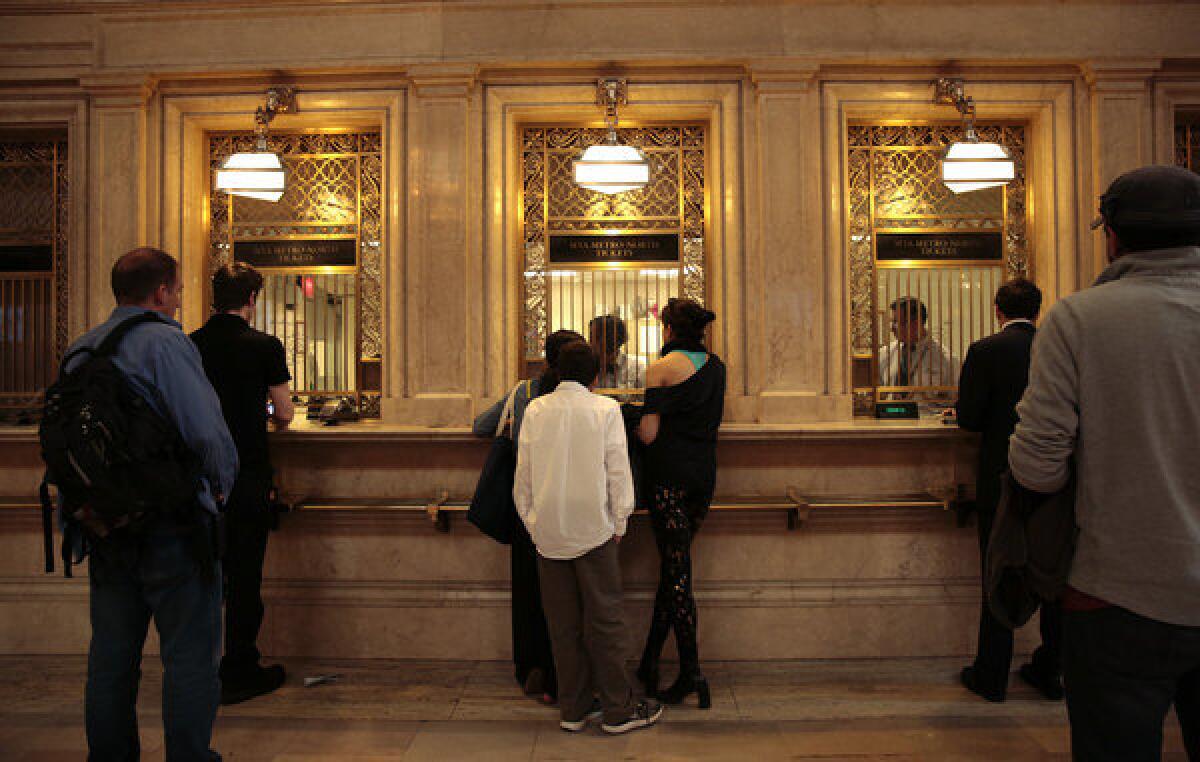
The ticket windows at Grand Central Terminal are framed by ornate brass covers and fixtures. More photos
"There are so many pieces of history like this, and we don't want to lose them," said Randall Fleischer, the vice president of Grand Central Terminal, as he stood on the original marble floor beneath chandeliers dipped in liquid gold.
Fleischer was in Los Angeles this year for a transit conference and said ideas discussed included turning L.A.'s Union Station ticketing area into a space for weddings, concerts and other cultural events, just as Grand Central did with its former waiting room.
As the design students' tour wound down, Brucker led them back to where they had begun nearly three hours earlier — to the main concourse, where he pointed out the oddities that might otherwise go unnoticed.
A hole above Pisces, one of the constellations etched on the concourse ceiling, is left over from 1957, when NASA decided to display a rocket in the terminal. Officials miscalculated the rocket's size, forcing them to puncture the ceiling to accommodate it.
There's a small, black rectangle on one edge of the sky-blue ceiling, a reminder of the stains left by decades of cigarette smoke. Workers using cheesecloth dipped in soapy water took one year, and $1 million, to scrub the ceiling back to its original state, but purposefully left that small reminder.
Brucker pointed out the chandeliers with their 35,000 light bulbs, a nod to Grand Central's all-electric underground rail system, which replaced the polluting steam engines that had once coursed through the city. He compared the gleaming concourse now with its state in the 1960s and '70s, when the homeless sheltered there.
Next, he answered the questions he had posed at the start of the tour, beginning with that 35,000-square-foot mistake. It is the concourse ceiling, which was supposed to replicate the October night sky. Because the artists did not work from a stencil, they depicted the constellations backward — an error not caught until after the terminal's grand opening on Feb. 2, 1913.
The multimillion-dollar jewel? It's the opal face of the giant clock perched atop the information booth, which also houses the secret stairway Brucker mentioned. The spiral staircase is concealed in a cylinder inside the booth, permitting the person working the kiosk to descend easily to another kiosk on the terminal's lower level.
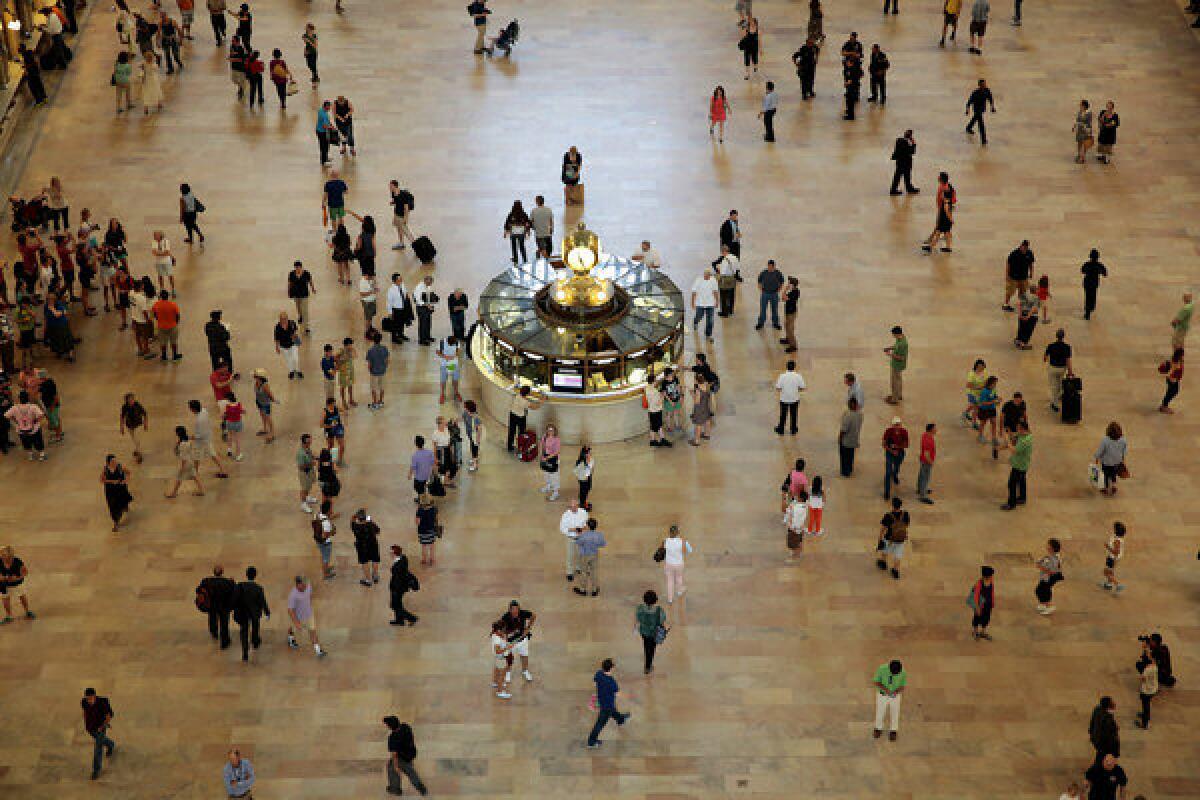
A view of the terminal that can be seen only from a spot on Brucker's tour. His tour groups have included ambassadors, politicians, rock stars, movie actors and TV personalities. More photos
As for the display board, Brucker explained that every departure time listed is one minute earlier than the trains' send-off — an intentional inaccuracy designed to give passengers an extra 60 seconds to board.
Toward the end, Brucker's joking manner gave way to one of reverence.
"We might have some dark times, we might have some deeply buried secrets, we might be a lot less than perfect — but this terminal is giving us a message about reclamation, about reinvention," he said. "This building was going to be torn down, destroyed, obliterated."
He then gestured toward the buzzing concourse and said proudly: "Well, now look at it."
Sign up for Essential California
The most important California stories and recommendations in your inbox every morning.
You may occasionally receive promotional content from the Los Angeles Times.
